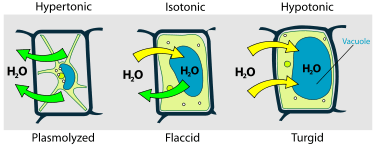Turgor pressure
| Look up turgid in Wiktionary, the free dictionary. |
Turgor pressure pushes the plasma membrane against the cell wall of plant, bacterial, and fungal cells as well as those protist cells which have cell walls.
This pressure, turgidity or turgidness, is caused by the osmotic flow of water from an area of low solute concentration outside the cell into the cell's vacuole, which has a higher solute concentration. Healthy plant cells are turgid and plants rely on turgidity to maintain rigidity. In contrast, this phenomenon is not observed in animal cells which have no cell walls to prevent them from being burst by the flow of water into the cell and must either continually pump out water, with a contractile vacuole, or live in an isotonic solution where there is no osmotic pressure.
Mechanism

A physical phenomenon known as osmosis causes water to flow from an area of low solute, high water concentration to an area of high solute, low water concentration, until the two areas have an equal ratio of solute to water. Normally, the solute diffuses toward equilibrium as well; however, all cells are surrounded by a lipid bilayer cell membrane which permits the flow of water in and out of the cell but restricts the flow of solute under many circumstances. As a result, when a cell is placed in a hypotonic solution, water rushes into the membrane, increasing the cell's volume.
Eventually, the cell's membrane is enlarged such that it pushes against the cell's rigid wall. At this point the cell is said to be turgid.[1] In an isotonic solution, water flows into the cell at the same rate at which it flows out. The pressure pushing the cell's membrane against its wall is reduced and the cell is said to be 'flaccid'. When a cell is placed in a hypertonic solution water actually flows out of the cell into the surrounding solution. This, plasmolysis, causes the membrane to recede from the wall and is responsible for wilting in plant cells.
Changes in turgor pressure strongly depends on cell volume: with an increase in cell volume, there is an increase in cell wall rigidity which leads in lower cell wall plasticity, and experiments show that small cells have resulted in a stronger elastic change compared to larger cell volumes. [2]
Turgor pressure also plays a key role in plant cell growth where the cell wall undergoes irreversible expansion due to the force of turgor pressure as well as structural changes in the cell wall that alter its extensibility. [3]
Turgor pressure in plants
Turgor pressure keeps plants upright and stiff. Any loss of turgor pressure makes plants wilt.
See also
References
- ↑ Campbell, Neil A.; Reece, Jane B.; Urry, Lisa A.; Cain, Michael L.; Wasserman, Steven A.; Minorsky, Peter V.; Jackson, Robert B. (2008). Biology (8th ed.). p. 134. ISBN 978-0-8053-6844-4.
- ↑ Steudle, E., & Zimmermann, U. (2016). Effect of Turgor Pressure and Cell Size on the Wall Elasticity of Plant Cells. Plant Physiology, (170). Retrieved March 5, 2016, from http://www.plantphysiol.org/content/59/2/285.full.pdf html
- ↑ Jordan, B.M., and Dumais, J. (2010). Biomechanics of Plant Cell Growth. Encyclopedia of Life Sciences. Retrieved March 17, 2016, from http://www.els.net/WileyCDA/ElsArticle/refId-a0022336.html